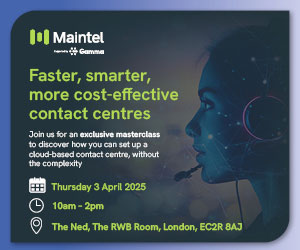Mike Palmer of Spearline argues that consistent and accurate presentation of Calling Line Identity (CLI) is something every contact centre needs, but may not be getting.
Caller ID in the Contact Centre
Whether your carrier partners are delivering customer calls to your centre or enabling your agents to reach out to your customers across international networks, consistent and accurate presentation of CLI is something your business needs.
What happens when your customer calls you, but there is no callback number?
What happens when you call back but your CLI is not presented correctly?
What Is Caller ID / CLI?
Caller ID, or CLI, provides the receiving end of a telephone call with the number of the calling phone. It is a technology that is often used in contact centres to identify the caller or the geographic location from which a call originated. Contact centre software has several fantastic functions that leverage CLI presentation to improve business performance – for both inbound and outbound call flows.
CLI is powerful through the lifespan of a customer call. It can add value before connecting to an agent, during the agent interaction, and also after agent interaction is complete.
When a customer calls the contact centre, CLI can be used to identify the best routing for the caller, matching the incoming phone number information to CRM (customer relationship management) data. With foundational information retrieved from the CRM record, relevant information about the customer is used to direct the call most appropriately.
Once an agent is in conversation with the customer, CTI (computer-telephony integration) uses caller ID to display information about the customer and their product use to the agent. With customer-specific information presented automatically to the agent, a powerfully personalized customer experience is provided.
Where a customer has contacted your business from a new originating number, the caller ID can be captured post-call and added to the customer’s CRM profile to enable greater personalization in future interactions.
Increasingly, contact centres are using virtual hold technology to manage queues, enhance customer experience and improve operations. In a virtual hold call-flow, inbound customers may be identified by caller ID, while the agent interaction is subsequently facilitated by an outbound call where the agent’s caller ID is an important feature in identifying your call as a “trusted caller” at the customer end.
What Happens When CLI Is Not Working For You?
The use of these features in an international contact centre environment is dependent on the accurate presentation of CLI, which can be a challenge. Caller ID is passed from carrier to carrier when a call is transmitted.
Unfortunately, carriers and regulatory bodies vary in their preferred formatting, and calls may transit several networks before reaching their destination. The caller ID information may be altered, distorted, or lost along the way. Where CLI isn’t presented, it can be an indication that a “grey route” is being used.
In the world of telecommunications, a “white route” is a route where both source and destination are legal terminations, a “black route” is one that is illegal at both ends. Common, especially in the VoIP world, is the notion of a “grey route“, where the routing of a call is legal for the party on one end, but illegal on the other end. These grey routes are known to negatively impact not only CLI presentation but also connection rates, audio quality, and DTMF recognition.

Mike Palmer
The absence of CLI may have inbound callers frustrated as routing decisions are impaired. Customers can experience longer hold times, inadequate information with the agent, multiple call transfers, and more.
Virtual hold callbacks are impacted. In a world where consumers are frustrated and annoyed by telemarketing and are cautious of potential scams, your callback to the customer absolutely needs to present clearly to the customer, or that conversation won’t happen.
For further information, visit www.spearline.com
Author: Robyn Coppell
Published On: 30th Oct 2019 - Last modified: 25th Jan 2023
Read more about - Guest Blogs, Spearline



































